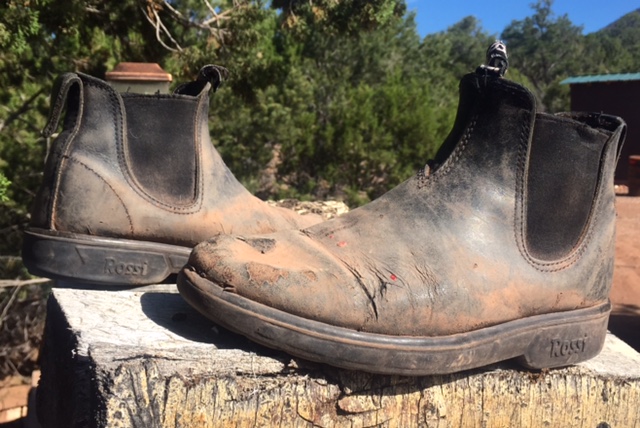 We’re starting a new feature here on ExhaustNotes.us called Tested To Destruction. TTD will be a life-cycle product test from purchase to the dumpster. You’ll not find so complete a product test anywhere else on the Internet, go ahead and look around. Due to the long test periods involved some of the products may be discontinued and no longer available. There’s not a lot we can do about that. One other note: By definition we are testing to destruction so all products will fail in the end. It happens to the best. Nothing lasts forever.
We’re starting a new feature here on ExhaustNotes.us called Tested To Destruction. TTD will be a life-cycle product test from purchase to the dumpster. You’ll not find so complete a product test anywhere else on the Internet, go ahead and look around. Due to the long test periods involved some of the products may be discontinued and no longer available. There’s not a lot we can do about that. One other note: By definition we are testing to destruction so all products will fail in the end. It happens to the best. Nothing lasts forever.
I first became aware of Rossi boots in Australia. Nearly every tradesman wore the things and the ones I spoke to raved about the classic, made in Australia boot. I was on extended leave in the outback and needed a tough boot for hiking and camping so I bought a pair of Rossi Enduras. The Rossies aren’t cheap (like me) but I splurged and who doesn’t love having boots named after the greatest modern-era motorcycle road racer?
The Rossies were comfortable from Day One. No blisters or slipping, soft and flexible with pull tabs and elastic sides to make installation a breeze. No wonder the Tradies wore them. That first pair lasted through Australia and back in the States through several boat rewires.
In my real job I worked in very oily conditions. The bilge of a commercial fishing boat is full of slimy gunk. Unlike every other boot or canvas shoe I have purchased, the Rossi soles stayed firmly attached to the uppers. The Rossies easily outlasted four pairs of regular boots.
One thing that disintegrates after a couple years is the rubber liner inside the bottom of the boot. This liner is supremely comfortable when new and I guess you can replace it with another liner. This has happened with both pairs I’ve owned. When mine fell apart I pulled out the pieces and kept on pouring concrete. The boot is still comfy without the liner, just less so.
The boots in the photo are my second pair of Rossies and they have gone through the wringer on countless construction jobs. Imagine: 2 pairs of boots for over 5 years of hard use. I used to go through work boots every 6 to 9 months. My second pair, like the first, never came apart and I’m retiring them only because they look so bad people keep offering me money for a cup of coffee.
I wear these boots when riding motorcycles, dirt or street. The comfort is great and being able to easily slip them off on hot rides is so nice. I know slip-on boots may fly loose in a crash situation so save your breath: I make my gear choices for me. You make your gear choices for you. Anyway, Flat Earthers and Vaccine Deniers tell me it’s safer to be thrown clear of the boot in an accident.
You can buy Rossi boots online but make sure to get the ones made in Adelaide, Australia. They’re not very stylish and you can expect to pay a lot but it’s like you’re getting four pairs of boots for the price of one. There are several boots that look the same as Rossies but are lower quality. Shop wisely.

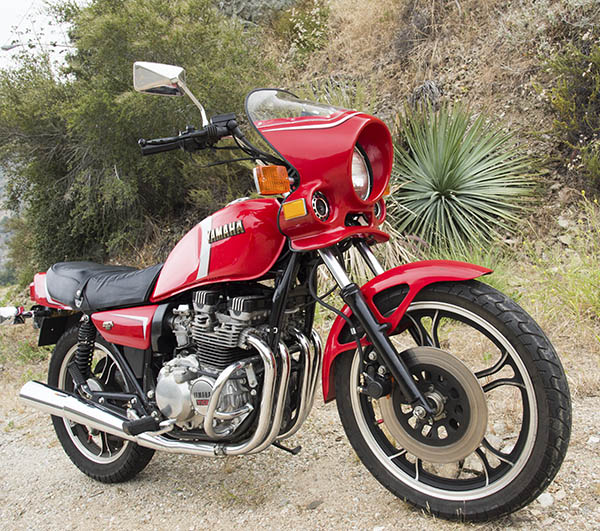
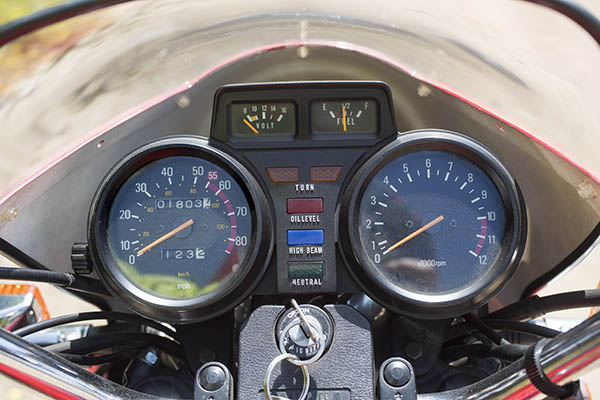
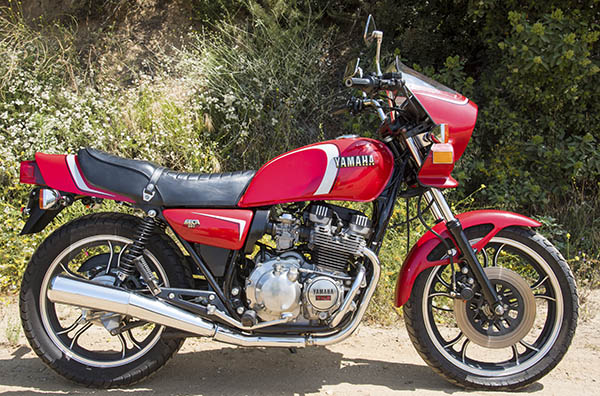
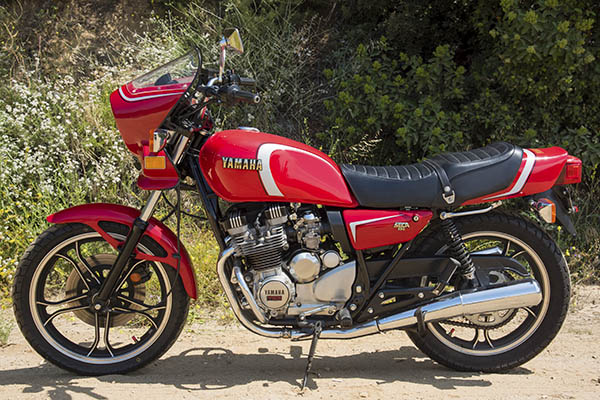
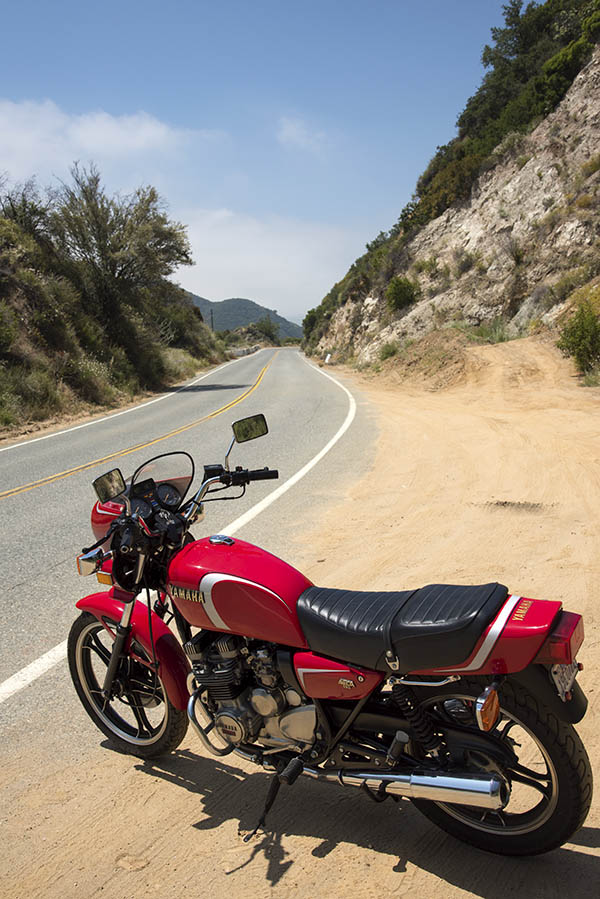
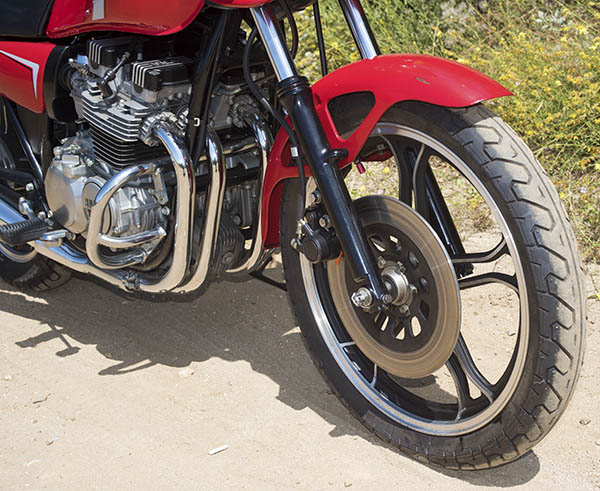
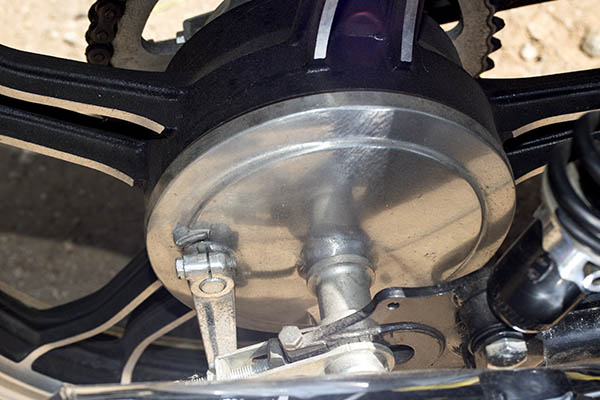
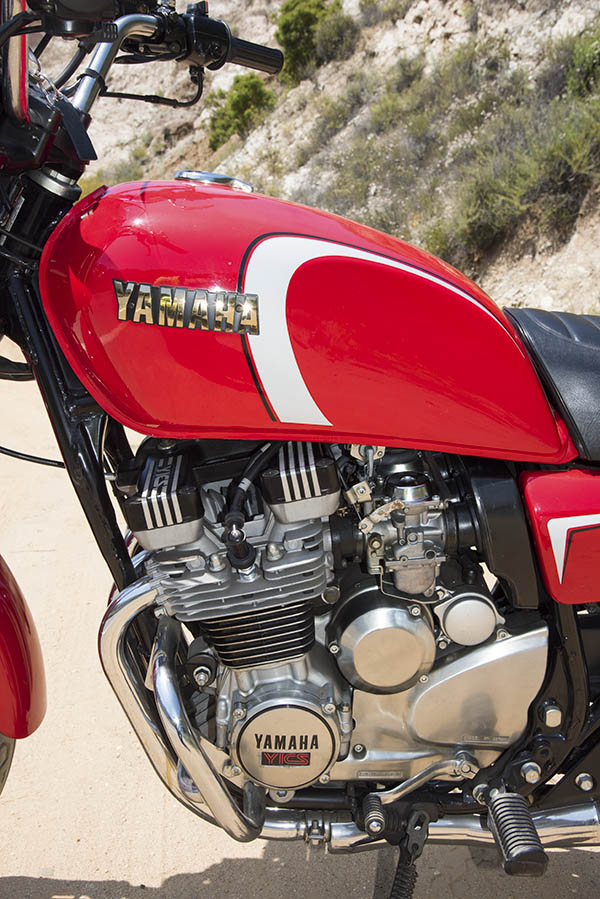
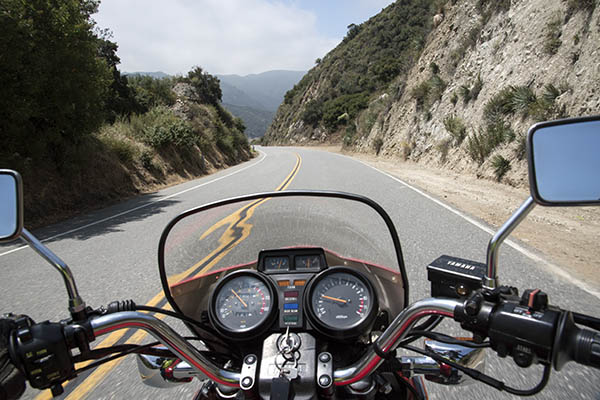
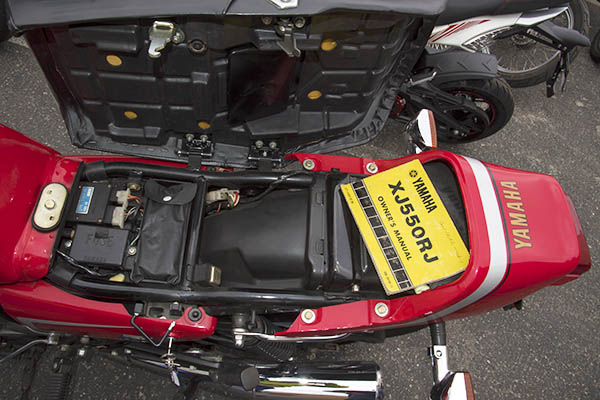
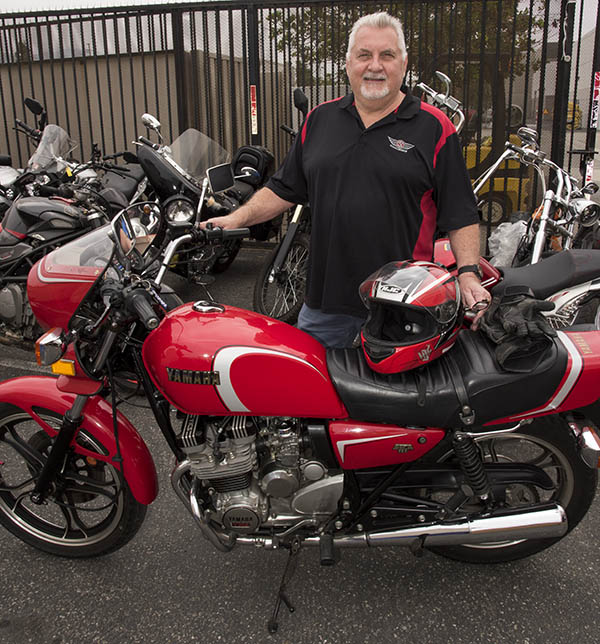
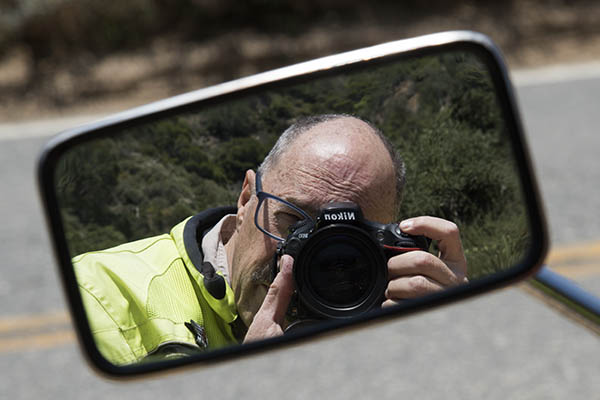
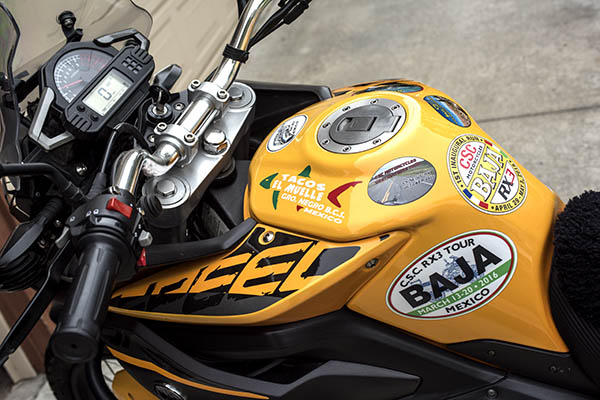
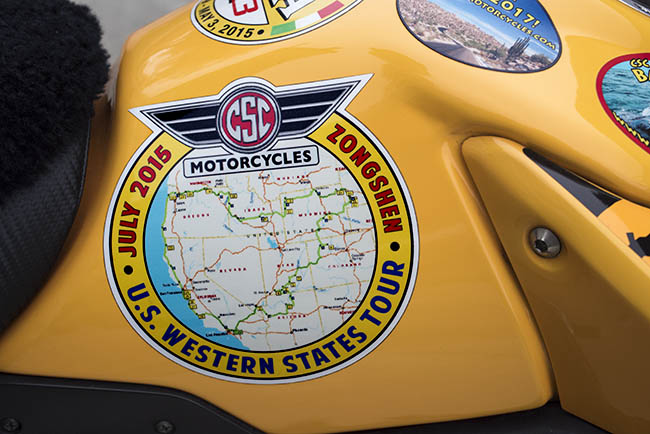
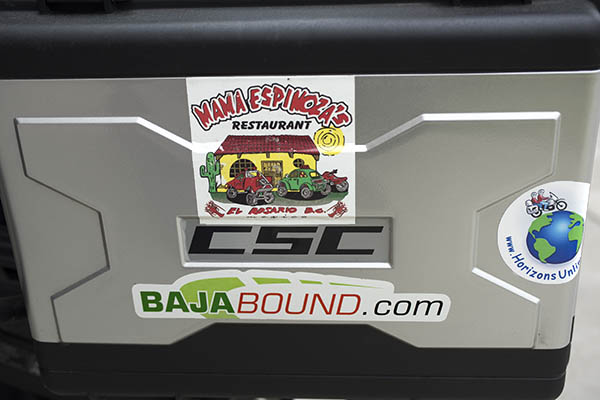
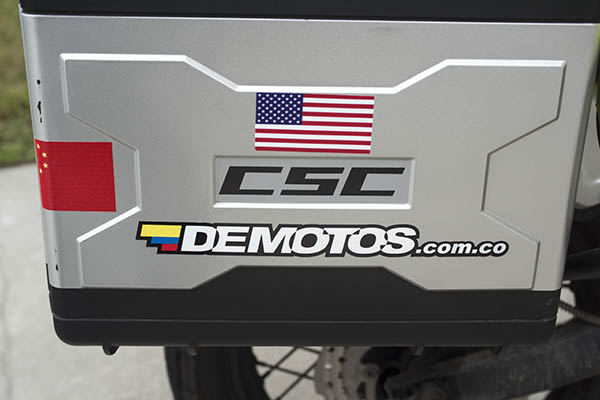
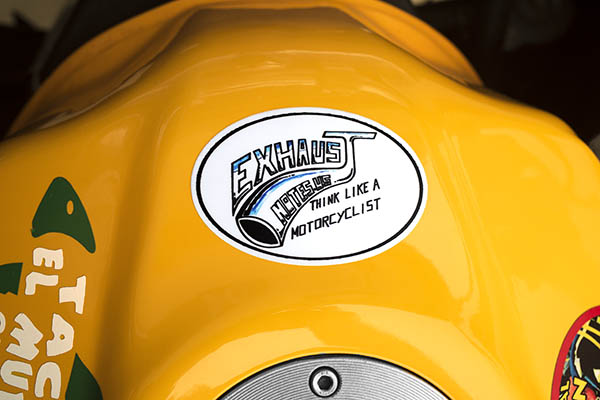
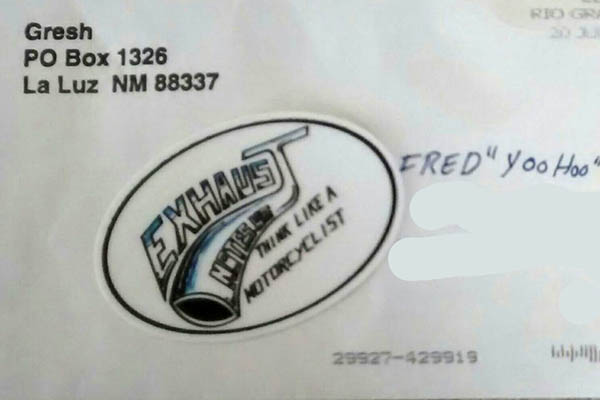
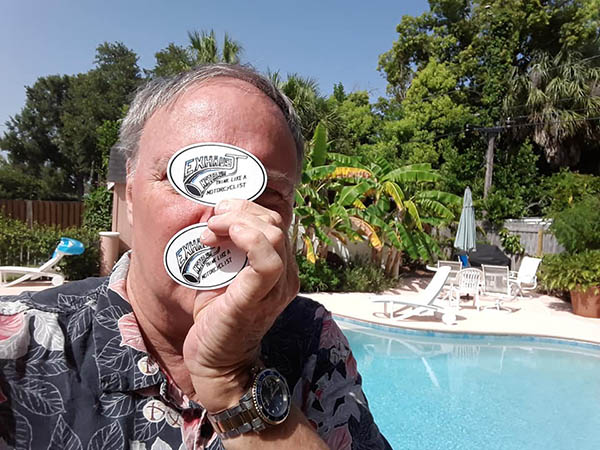 None other than our good buddy Robert has an ExNotes decal on his Sporty…
None other than our good buddy Robert has an ExNotes decal on his Sporty…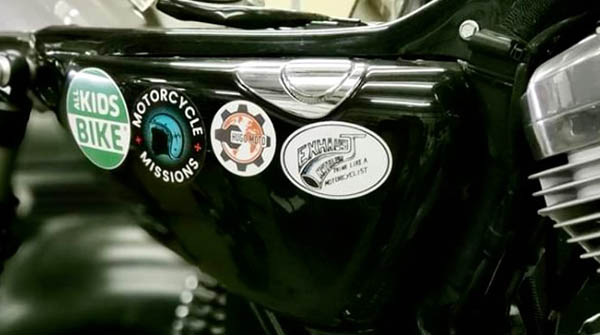 And good buddy Carlos never leaves home without his overhead publicity…
And good buddy Carlos never leaves home without his overhead publicity… Hey, be one of the cool kids! Get your very own ExNotes decals!
Hey, be one of the cool kids! Get your very own ExNotes decals!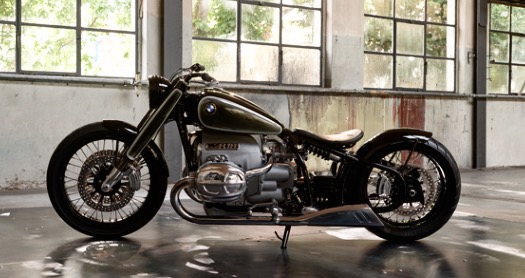 BMW’s R18 Concept is that rare thing in the motorcycle world: a BMW that doesn’t look like the contents of the junk drawer in your kitchen. Most of the GS series have a rubber band, plastic-handled corkscrew and expired AA batteries look about them. Cluttered and stolen-valor-military-ish, the big GS’s take a concerted effort to look at without smirking and feeling superior. Except for the very first ones. The early GS800 was much cleaner and actually was pretty good off road.
BMW’s R18 Concept is that rare thing in the motorcycle world: a BMW that doesn’t look like the contents of the junk drawer in your kitchen. Most of the GS series have a rubber band, plastic-handled corkscrew and expired AA batteries look about them. Cluttered and stolen-valor-military-ish, the big GS’s take a concerted effort to look at without smirking and feeling superior. Except for the very first ones. The early GS800 was much cleaner and actually was pretty good off road. Concept bikes are a great way to get the reaction of the riding public without spending a bunch of money on a bike nobody likes. It’s smart to ask your customers first. Personally, I love the thing. It has a vibe that goes all the way back to the beginning of BMW. Back when they were still trying to kill us all.
Concept bikes are a great way to get the reaction of the riding public without spending a bunch of money on a bike nobody likes. It’s smart to ask your customers first. Personally, I love the thing. It has a vibe that goes all the way back to the beginning of BMW. Back when they were still trying to kill us all. The seat on the R18 is a concession to the Brat trend that is slowly but surely vandalizing Honda’s entire production output from the 1970’s. I would prefer a dual seat more like the old R69 came with. It seems a waste for such a long bike to neglect the pillion accommodations. The long reach to the bars is another styling cue that will probably make it into production. Motorcyclists have proven time and time again that they will put up with any silly riding position as long as it makes them cool.
The seat on the R18 is a concession to the Brat trend that is slowly but surely vandalizing Honda’s entire production output from the 1970’s. I would prefer a dual seat more like the old R69 came with. It seems a waste for such a long bike to neglect the pillion accommodations. The long reach to the bars is another styling cue that will probably make it into production. Motorcyclists have proven time and time again that they will put up with any silly riding position as long as it makes them cool. The front end has about 1-inch of travel, generous for the cruiser segment. I hope BMW replicates that crazy-huge, aerodynamic skeleton key when they design the keyless proximity fob for this bike. Come to think of it all those keyless entry thingies are too big to fit in the skintight leather rockabilly pants you’ll be wearing on the R18. Maybe a plain old key would be better. The headlight nacelle looks great if a bit Royal Enfield Bullet-ish. Hey, that’s ok.
The front end has about 1-inch of travel, generous for the cruiser segment. I hope BMW replicates that crazy-huge, aerodynamic skeleton key when they design the keyless proximity fob for this bike. Come to think of it all those keyless entry thingies are too big to fit in the skintight leather rockabilly pants you’ll be wearing on the R18. Maybe a plain old key would be better. The headlight nacelle looks great if a bit Royal Enfield Bullet-ish. Hey, that’s ok. My biggest concern about the R18 is not the bike itself but the manufacturer. BMW puts entirely too many electronic doodads on their modern bikes. The excessive reliance on E-trickery to protect the rider from himself has created heavy motorcycles. BMW used to pride itself on lightweight motorcycles. It was in their advertisements! The damn things may be safer as long as they don’t land on you but reliability has suffered with the additional complexity.
My biggest concern about the R18 is not the bike itself but the manufacturer. BMW puts entirely too many electronic doodads on their modern bikes. The excessive reliance on E-trickery to protect the rider from himself has created heavy motorcycles. BMW used to pride itself on lightweight motorcycles. It was in their advertisements! The damn things may be safer as long as they don’t land on you but reliability has suffered with the additional complexity. Glenn sent me a few photos from the old days and one that got my attention was a shot of us building a Sportster in the living room of the shack we used to live in. Having a living room to work in was a luxury because prior to renting the shack I was homeless. I had an old Chevy truck with a bench seat that I could stretch out enough to get some sleep and I had a job that let me take a dry bath in the restroom after work. But when Admiralty Marine closed its doors for the evening I was on my own until the next morning. The boss let me know that the situation couldn’t go on forever and that I really needed to find a place to live.
Glenn sent me a few photos from the old days and one that got my attention was a shot of us building a Sportster in the living room of the shack we used to live in. Having a living room to work in was a luxury because prior to renting the shack I was homeless. I had an old Chevy truck with a bench seat that I could stretch out enough to get some sleep and I had a job that let me take a dry bath in the restroom after work. But when Admiralty Marine closed its doors for the evening I was on my own until the next morning. The boss let me know that the situation couldn’t go on forever and that I really needed to find a place to live.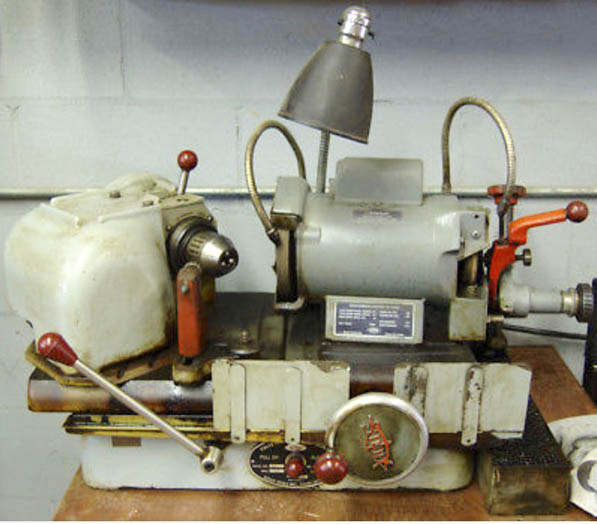 The Sportster’s high dome pistons were ok so a quick hone job and a set of rings finished off the top end. After that you’d think I’d leave the engine alone but I had to have a tin primary cover like the XR750 flat trackers ran.
The Sportster’s high dome pistons were ok so a quick hone job and a set of rings finished off the top end. After that you’d think I’d leave the engine alone but I had to have a tin primary cover like the XR750 flat trackers ran. I guess we’ll find out. The first rough draft of the exhaustnotes.us sticker was a simple design using the popular, exhaust-pipe-streaming-off-a-letter style. This is not a new innovation but then neither is a motorcycle blog. The design needed to work with T-shirts and other future swag projects. We wanted it hand-drawn because Berk and I are old school and we are not wasting your time trying to appear otherwise.
I guess we’ll find out. The first rough draft of the exhaustnotes.us sticker was a simple design using the popular, exhaust-pipe-streaming-off-a-letter style. This is not a new innovation but then neither is a motorcycle blog. The design needed to work with T-shirts and other future swag projects. We wanted it hand-drawn because Berk and I are old school and we are not wasting your time trying to appear otherwise. Next we applied a little color to the design, not too much to keep costs down later on in the life of the logo. The chrome reflections and sky blue harken back to the Cycletoons/Cartoons magazines we read as whelps.
Next we applied a little color to the design, not too much to keep costs down later on in the life of the logo. The chrome reflections and sky blue harken back to the Cycletoons/Cartoons magazines we read as whelps. After we agreed on the layout the design was tightened up. The “E” fitted to the pipe better and the pipe was fatter and curved down more. We eliminated quotation marks on the motto and straightened out the lettering a bit.
After we agreed on the layout the design was tightened up. The “E” fitted to the pipe better and the pipe was fatter and curved down more. We eliminated quotation marks on the motto and straightened out the lettering a bit. Now the real work began: Inking the outlines and making every bold line pop out. We needed to make the design strong enough to survive shrinking in size or enlarging. A cheerful children’s watercolor set brightened things up without being hard to duplicate on clothing, stuff bags or tramp stamps.
Now the real work began: Inking the outlines and making every bold line pop out. We needed to make the design strong enough to survive shrinking in size or enlarging. A cheerful children’s watercolor set brightened things up without being hard to duplicate on clothing, stuff bags or tramp stamps. The final design was sent to
The final design was sent to  East of Ruidoso, I steered the Husqvarna off of Highway 70 onto Devils Canyon Road and followed the twisting, smoothly-graded dirt until it dead-ended at Highway 220. Back on asphalt I turned right, rode past the airport and pulled into Fort Stanton, New Mexico.
East of Ruidoso, I steered the Husqvarna off of Highway 70 onto Devils Canyon Road and followed the twisting, smoothly-graded dirt until it dead-ended at Highway 220. Back on asphalt I turned right, rode past the airport and pulled into Fort Stanton, New Mexico. The Officers Quarters played host to Lieutenant John Pershing, who made good later on in life as General Black Jack Pershing. The OQ is divided into two story apartments with thick stone walls between. One section of the wall was damaged showing the rubble-filled core of the finished walls. This type of construction took a lot of manpower to build.
The Officers Quarters played host to Lieutenant John Pershing, who made good later on in life as General Black Jack Pershing. The OQ is divided into two story apartments with thick stone walls between. One section of the wall was damaged showing the rubble-filled core of the finished walls. This type of construction took a lot of manpower to build.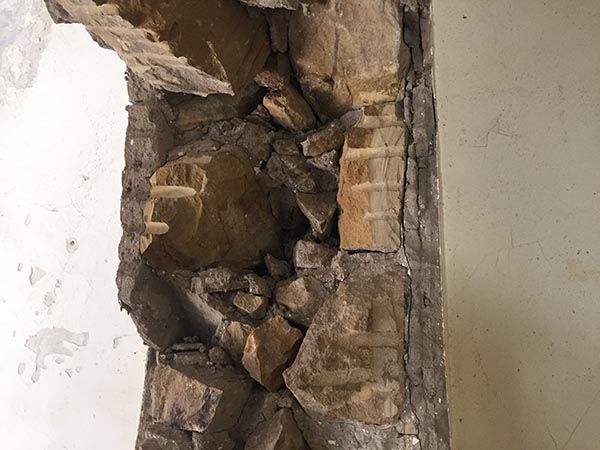
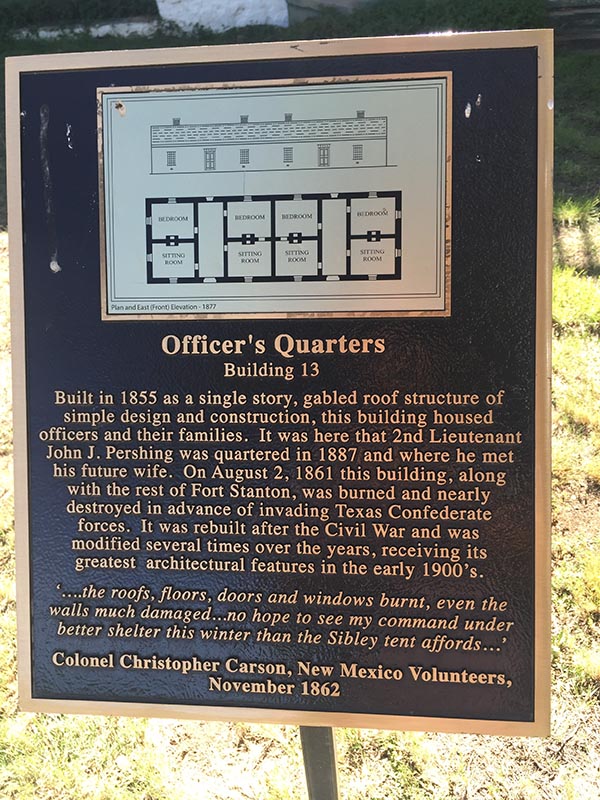 New Mexico’s clean dry air was the ideal spot to treat tuberculosis and in the 1930’s a modern hospital was built to care for easterners suffering from the unsanitary conditions prevailing at that time. The hospital sported New Mexico’s very first elevator along with dental facilities and entertainment. The patients however had to sleep outside in a tent city as it was believed plenty of fresh air and good food was the cure. It worked pretty well too.
New Mexico’s clean dry air was the ideal spot to treat tuberculosis and in the 1930’s a modern hospital was built to care for easterners suffering from the unsanitary conditions prevailing at that time. The hospital sported New Mexico’s very first elevator along with dental facilities and entertainment. The patients however had to sleep outside in a tent city as it was believed plenty of fresh air and good food was the cure. It worked pretty well too.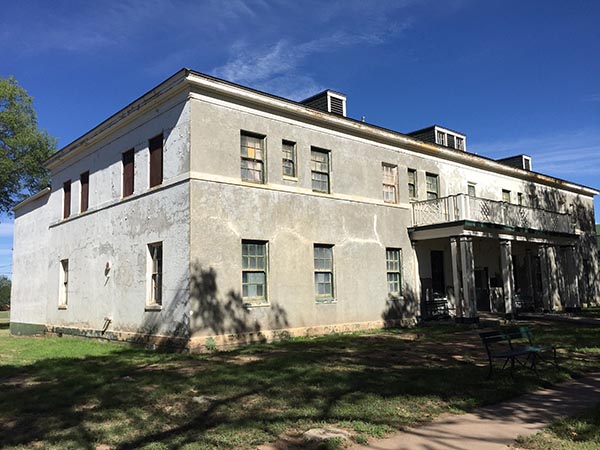 It’s ok to ride your motorcycle on the paved roads in the fort. On a back street there are more recent buildings and a nice stone church. I’m not into religion but I love to check out the buildings religious people have constructed. The little church at Fort Stanton is a jewel. It was open the day I was there and the place was clean and neat. For all I know believers may still worship here. You’re not allowed to tramp through the brush but behind the church a couple hundred yards are the remains of a swimming pool German prisoners of war built to stave off boredom and have a place to cool off in the summertime.
It’s ok to ride your motorcycle on the paved roads in the fort. On a back street there are more recent buildings and a nice stone church. I’m not into religion but I love to check out the buildings religious people have constructed. The little church at Fort Stanton is a jewel. It was open the day I was there and the place was clean and neat. For all I know believers may still worship here. You’re not allowed to tramp through the brush but behind the church a couple hundred yards are the remains of a swimming pool German prisoners of war built to stave off boredom and have a place to cool off in the summertime.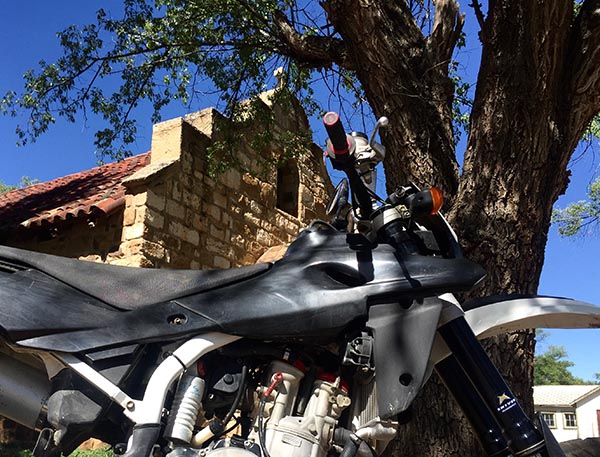
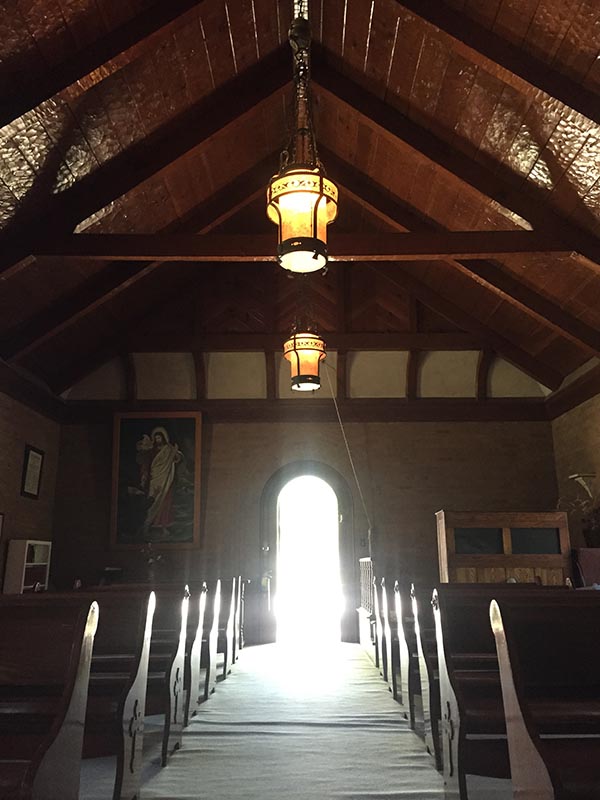 Right next door to the Officer’s Quarters is the Nurse’s quarters. I don’t know if the two uses ran concurrently but if they did this little corner of Fort Stanton must have been a happening spot. The Nurse’s quarters were in sad shape except for the main entrance, which had beautiful beams holding up the roof.
Right next door to the Officer’s Quarters is the Nurse’s quarters. I don’t know if the two uses ran concurrently but if they did this little corner of Fort Stanton must have been a happening spot. The Nurse’s quarters were in sad shape except for the main entrance, which had beautiful beams holding up the roof.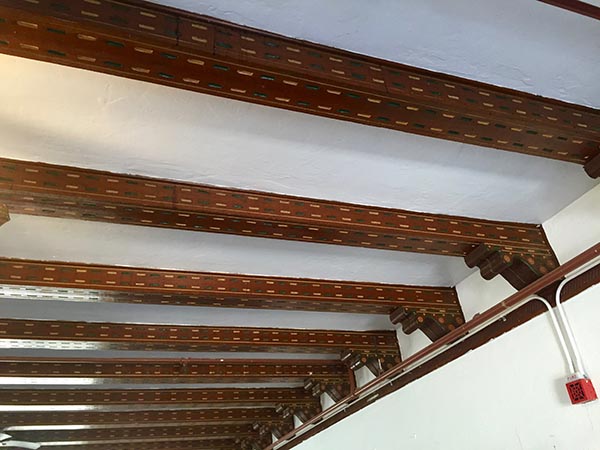 Fort Stanton isn’t overrun with tourists. Even though it was part of a war machine, wandering around inside the buildings gives you a sense of peace. Sit on one of the benches in the bright New Mexico sun and you can imagine the soldiers marching the grounds in formation; the gentle coughing of the slowly recovering patients and the laughter and splashing of lucky Germans who were spared death in World War 2.
Fort Stanton isn’t overrun with tourists. Even though it was part of a war machine, wandering around inside the buildings gives you a sense of peace. Sit on one of the benches in the bright New Mexico sun and you can imagine the soldiers marching the grounds in formation; the gentle coughing of the slowly recovering patients and the laughter and splashing of lucky Germans who were spared death in World War 2.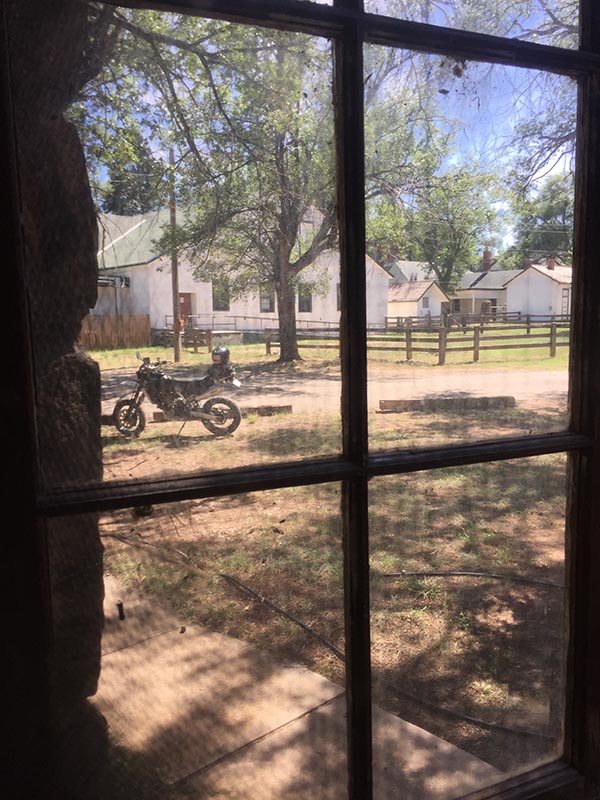
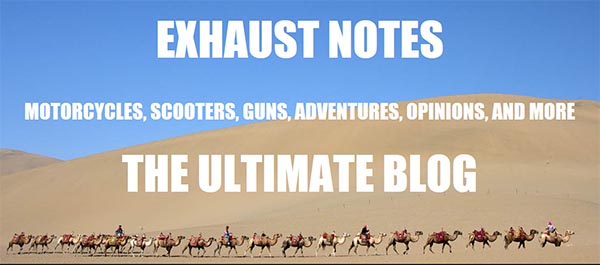
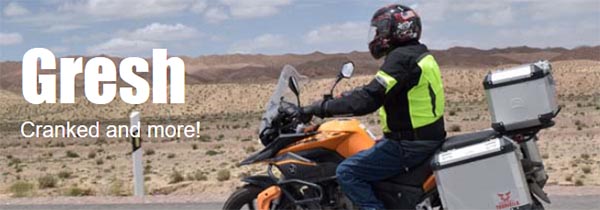

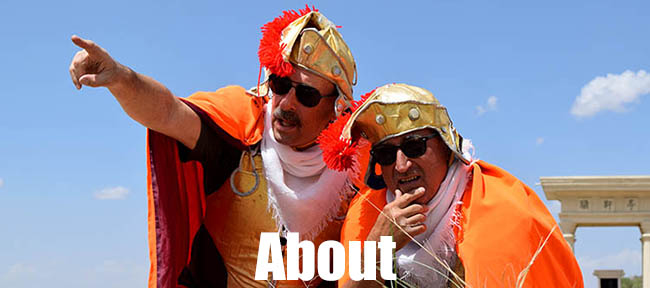

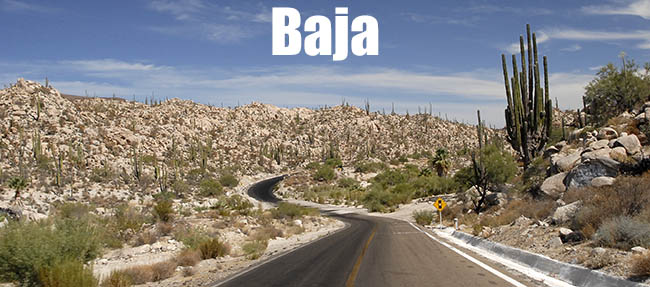
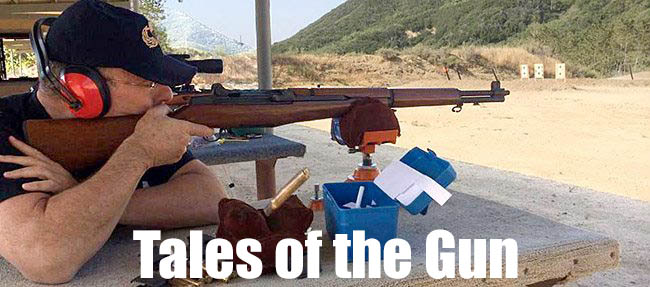
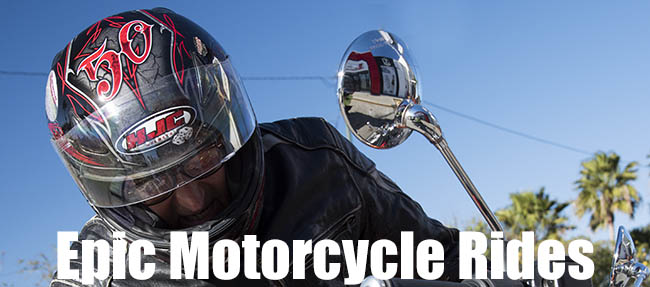
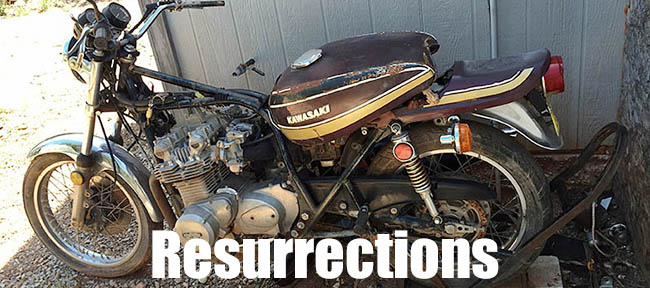
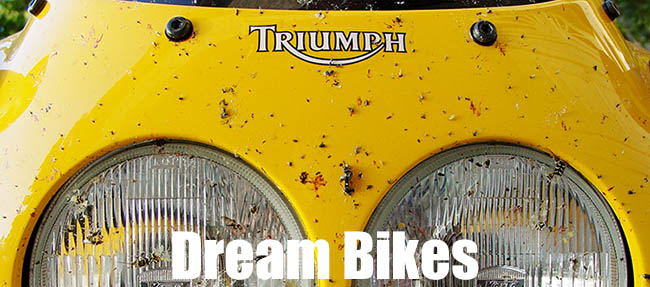

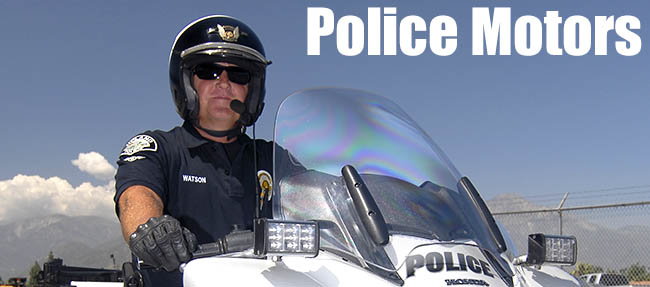
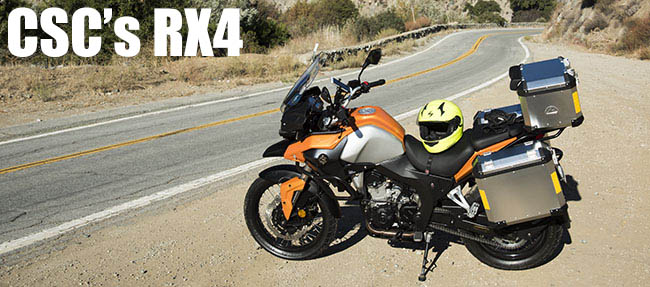
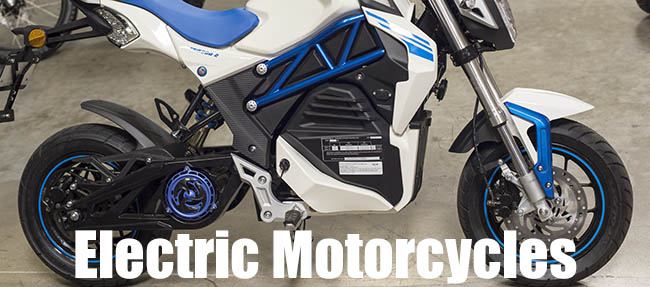
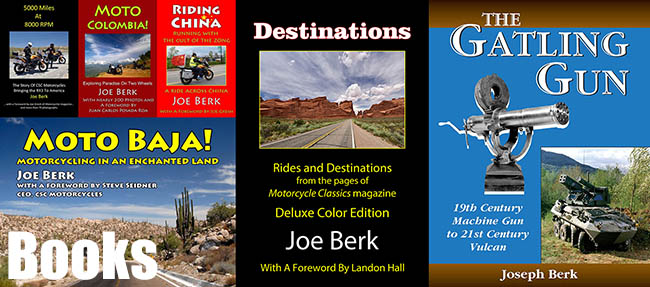
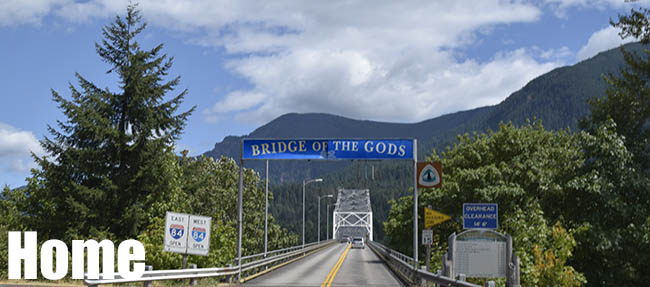
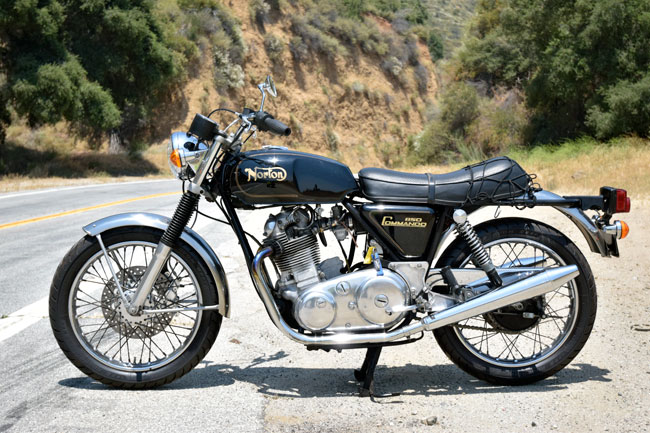 Hey, there’s more good stuff coming your way. We do our best to blog every day, and we’ve got great stories lined up for you:
Hey, there’s more good stuff coming your way. We do our best to blog every day, and we’ve got great stories lined up for you: There are more ways to measure wealth than money. Sure, traditionalists rely on a strict net worth approach, adding up the figures on electronic statements in a system where the winner is whoever has the highest number. You can count all sorts of things, though. You can count friends, you can count grandchildren, you can count experiences: These are forms of wealth that won’t show up on that balance email from the bank.
There are more ways to measure wealth than money. Sure, traditionalists rely on a strict net worth approach, adding up the figures on electronic statements in a system where the winner is whoever has the highest number. You can count all sorts of things, though. You can count friends, you can count grandchildren, you can count experiences: These are forms of wealth that won’t show up on that balance email from the bank. On of my largest assets is the 4-speed Suburban project. When I bought the ’90 ‘Burb it came with a malfunctioning automatic transmission. I hate automatics and malfunctioning ones even more so. The 700R4 works in Drive and Reverse but not in 1-2-3. The truck runs fine and it will tote a 3000-pound load without complaint but that boring automatic has got to go. It’s a rare Suburban that came with a 4-speed from the factory and even rarer to see a ½-ton version. I’ve only seen one 4-speed ‘Burb and it was ¾-on. This project keeps earning interest and I’ve been training a weather eye on Internet sale sites for a cheap, manual transmission, 4X4 GM truck to steal the guts from. I found a late model, 4X4-IFS 1/2-ton truck with a 5-speed and a nice FI engine that ran well but the transfer case and transmission housing were broken and besides everything was on the wrong side for the old straight axle suburban.
On of my largest assets is the 4-speed Suburban project. When I bought the ’90 ‘Burb it came with a malfunctioning automatic transmission. I hate automatics and malfunctioning ones even more so. The 700R4 works in Drive and Reverse but not in 1-2-3. The truck runs fine and it will tote a 3000-pound load without complaint but that boring automatic has got to go. It’s a rare Suburban that came with a 4-speed from the factory and even rarer to see a ½-ton version. I’ve only seen one 4-speed ‘Burb and it was ¾-on. This project keeps earning interest and I’ve been training a weather eye on Internet sale sites for a cheap, manual transmission, 4X4 GM truck to steal the guts from. I found a late model, 4X4-IFS 1/2-ton truck with a 5-speed and a nice FI engine that ran well but the transfer case and transmission housing were broken and besides everything was on the wrong side for the old straight axle suburban. The chalky blue, 1974 MG GT came with Tinfiny Ranch and was listed as an out building on the deed. This car was on the chopping block until I started reading about MG’s with Buick 215 cubic-inch aluminum engine swaps. I really have to stay off the internet. The Buick engine triples the horsepower, doesn’t weigh much more than the iron 4-banger it replaces and sounds cool as hell revved up to 6000 RPM. This is one asset I kind of wish was not in my Project Bank as I’ve never been that interested in cars. Still, it’s there waiting on me.
The chalky blue, 1974 MG GT came with Tinfiny Ranch and was listed as an out building on the deed. This car was on the chopping block until I started reading about MG’s with Buick 215 cubic-inch aluminum engine swaps. I really have to stay off the internet. The Buick engine triples the horsepower, doesn’t weigh much more than the iron 4-banger it replaces and sounds cool as hell revved up to 6000 RPM. This is one asset I kind of wish was not in my Project Bank as I’ve never been that interested in cars. Still, it’s there waiting on me. Tinfiny Ranch itself is a huge source of endless work, but beyond the physical plant The Ranch continues to deposit surprises into my Project Bank. This Merry Tiller project revealed itself as I was hauling away two, multi-panel garage doors. The doors sections were stacked with spacers in the popular rat-paradise fashion and I gave chase to a couple fat rats but they got away from me in the thick brush down by the ravine. The Merry Tiller looks like it will come in handy for the raised-bed vegetable garden (yet another deposit in The Project Bank) I’m planning for the back yard. The engine on the tiller is not stuck and being a Briggs & Stratton I’m sure it will run so I’m leaving it in The Bank for safe keeping.
Tinfiny Ranch itself is a huge source of endless work, but beyond the physical plant The Ranch continues to deposit surprises into my Project Bank. This Merry Tiller project revealed itself as I was hauling away two, multi-panel garage doors. The doors sections were stacked with spacers in the popular rat-paradise fashion and I gave chase to a couple fat rats but they got away from me in the thick brush down by the ravine. The Merry Tiller looks like it will come in handy for the raised-bed vegetable garden (yet another deposit in The Project Bank) I’m planning for the back yard. The engine on the tiller is not stuck and being a Briggs & Stratton I’m sure it will run so I’m leaving it in The Bank for safe keeping.